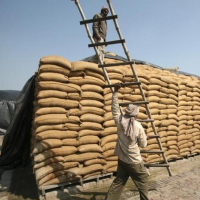FM Blames Hoarding for Inflation, But Govt Procurement Is Part of the Problem
 Foodgrain stocks at a Food Corporation of India warehouse
Foodgrain stocks at a Food Corporation of India warehouse
Inflation hit a five-month high of 6.01% in May, complicating the Indian government’s plan to revive growth in the sluggish economy. Forecasts of a weak monsoon, on which most of India's food crops depend, have added to inflation fears, with prices of fruits and vegetables rising by double digits.
Finance Minister Arun Jaitley has blamed "speculative hoarding" and higher energy costs for the rise in wholesale prices.
But the biggest food hoarder in the country is the Food Corporation of India (FCI), the government’s procurement arm. It is required to maintain buffers of rice, wheat and other cereals for distribution at subsidized prices through the Public Distribution System (PDS).
The FCI has consistently kept more buffer stocks than required, but these have now ballooned to more than four times. The agency is hoarding over 62 million tonnes of rice and wheat in its godowns across India, along with 11.3 million tonnes of unmilled paddy and small quantities of coarse grains. Much of these stocks are later found to be rotting because they are kept in the open under tarpaulin sheets in the rain.
If the ambitious Food Security Act were in force, around 50-55 million tonnes would be needed annually. But current stocks are 20 per cent higher than even this figure.
The Finance Minister needs to stop blaming traders and housewives for holding food stocks – the FCI is a far bigger culprit. He has now moved in the right direction by directing the agency to start releasing some of its stock to cool prices. An additional 5 million tonnes of rice will be sold in the open market.
A longer-term solution would be to reduce the quantity that the FCI buys from farmers in the first place. This may be politically difficult. The previous Congress government kept raising the Minimum Support Prices at which it bought from farmers. This kept farmers happy, but resulted in the FCI paying high prices for stocks it didn’t need and which were destined to be sold at lower prices anyway.
At current levels, the FCI is procuring more than 30% of India’s foodgrain production – this percentage needs to be brought down over time. That would free up supplies to keep prices down.
Another solution would be to incentivize farmers to switch to other crops. India grows far more wheat and rice than it needs. According to R Jagannathan of Firstpost, what is needed now is cereal production to deliver more protein to the population.
A third solution would be to expand cold chain facilities and refrigerated transport across the country to prevent the spoilage of fruits and vegetables between farmer and consumer. The Food and Agriculture Organization (FAO) estimates that India loses 40 per cent of its fruit and vegetable production en route. That wastage is the biggest reason behind volatile supplies and higher prices.
India has 6,300 cold storage facilities with an installed capacity of 30 million tonnes, but this is only half the capacity that India actually needs.
Jaitley certainly has a lot on his plate at the moment. But as he prepares his maiden Budget expected next month, he should include these long-term measures in his policy planning to help India out of its food inflation spiral.
- Karan Singh
- Top Stories
- Controversies
- Where is the Money Going?
- India and the World
- Appointments and Resignations
- Unusual News
- Latest News
- India College Chain’s Expansion into U.S. Draws Opposition from Massachusetts Officials over Quality of Education
- Milk Shortages in India Tied to Release of New Movies Featuring Nation’s Favorite Stars
- Confusion Swirls around Kashmir Newspaper Ban in Wake of Violent Street Protests
- Polio-Free for 5 Years, India Launches Vaccine Drive after Polio Strain Discovery
- New Aviation Policy Could Increase Service, Lower Ticket Prices






Comments